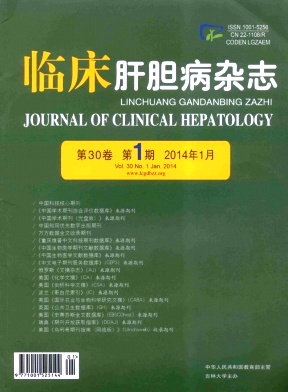|
[1]BRINDLEY SM, LANHAM AM, KARRER FM, et al.Cytomegalovirus-specific T-cell reactivity in biliary atresia at the time of diagnosis is associated with deficits in regulatory T cells[J].Hepatology, 2012, 55 (4) :1130-1138.
|
|
[2]CUI S, LEYVA-VEGA M, TSAI EA, et al.Evidence from human and zebrafish that GPC1 is a biliary atresia susceptibility gene[J].Gastroenterology, 2013, 144 (5) :1107-1115, e1103.
|
|
[3]CHEN CL, CONCEJERO A, WANG CC, et al.Living donor liver transplantation for biliary atresia:a single-center experience with first 100 cases[J].Am J Transplant, 2006, 6 (11) :2672-2679.
|
|
[4]XIA Q, LI QG.Surgical treatment of congenital atresia of biliary duct[J].J Clin Surg, 2007, 15 (4) :222-223. (in Chinese) 夏强, 李齐根.先天性胆道闭锁的外科治疗[J].临床外科杂志, 2007, 15 (4) :222-223.
|
|
[5]GOSS JA, SHACKLETON CR, MCDIARMID SV, et al.Longterm results of pediatric liver transplantation:an analysis of 569transplants[J].Ann Surg, 1998, 228 (3) :411-420.
|
|
[6]FARMER DG, VENICK RS, MCDIARMID SV, et al.Predictors of outcomes after pediatric liver transplantation:an analysis of more than 800 cases performed at a single institution[J].J Am Coll Surg, 2007, 204 (5) :904-916.
|
|
[7]ZHU JJ, XIA Q, ZHANG JJ, et al.Forty-four living donor liver transplantations for children with biliary atresia[J].Chin J Organ Transplant, 2011, 32 (7) :415-418. (in Chinese) 朱建军, 夏强, 张建军, 等.活体肝移植治疗儿童胆道闭锁44例[J].中华器官移植杂志, 2011, 32 (7) :415-418.
|
|
[8]TANG XY, XIA Q, ZHANG JJ, et al.Application of immunosuppressive agents in children with pediatric living-donor liver transplantation[J].Chin J Organ Transplant, 2012, 33 (5) :283-286. (in Chinese) 汤晓寅, 夏强, 张建军, 等.小儿活体肝移植后免疫抑制剂的应用体会[J].中华器官移植杂志, 2012, 33 (5) :283-286.
|
|
[9]RAIA S, NERY JR, MILES S.Liver transplantation from live donors[J].Lancet, 1989, 2 (8661) :497.
|
|
[10]MCDIARMID SV, ANAND R, LINDBLAD AS.Studies of Pediatric Liver Transplantation:2002 update.An overview of demographics, indications, timing, and immunosuppressive practices in pediatric liver transplantation in the United States and Canada[J].Pediatr Transplant, 2004, 8 (3) :284-294.
|
|
[11]OHI R, MOCHIZUKI I, KOMATSU K, et al.Portal hypertension after successful hepatic portoenterostomy in biliary atresia[J].J Pediatr Surg, 1986, 21 (3) :271-274.
|
|
[12]OTTE JB, de VILLE de GOYET J, REDING R, et al.Sequential treatment of biliary atresia with Kasai portoenterostomy and liver transplantation:a review[J].Hepatology, 1994, 20 (1 Pt 2) :s41-s48.
|
|
[13]MAHADEB P, GRAS J, SOKAL E, et al.Liver transplantation in children with fulminant hepatic failure:The UCL experience[J].Pediatr Transplant, 2009, 13 (4) :414-420.
|
|
[14]LEE KW, CAMERON AM, MALEY WR, et al.Factors affecting graft survival after adult/child split-liver transplantation:analysis of the UNOS/OPTN data base[J].Am J Transplant, 2008, 8 (6) :1186-1196.
|
|
[15]BOURDEAUX C, TRI TT, GRAS J, et al.PELD score and posttransplant outcome in pediatric liver transplantation:a retrospective study of 100 recipients[J].Transplantation, 2005, 79 (9) :1273-1276.
|
|
[16]MCDIARMID SV, ANAND R, MARTZ K, et al.A multivariate analysis of pre-, peri-, and post-transplant factors affecting outcome after pediatric liver transplantation[J].Ann Surg, 2011, 254 (1) :145-154.
|
|
[17]EVRARD V, OTTE JB, SOKAL E, et al.Impact of surgical and immunological parameters in pediatric liver transplantation:a multivariate analysis in 500 consecutive recipients of primary grafts[J].Ann Surg, 2004, 239 (2) :272-280.
|
|
[18]XIA Q, ZHANG JJ, LI QG, et al.Pediatric living donor liver transplantation:a report of 33 cases[J].Chin J Dig Surg, 2011, 10 (1) :40-43. (in Chinese) 夏强, 张建军, 李齐根, 等.婴幼儿活体肝移植33例[J].中华消化外科杂志, 2011, 10 (1) :40-43.
|
|
[19]TAKAHASHI Y, NISHIMOTO Y, MATSUURA T, et al.Surgical complications after living donor liver transplantation in patients with biliary atresia:a relatively high incidence of portal vein complications[J].Pediatr Surg Int, 2009, 25 (9) :745-751.
|
|
[20]MIZUTA K, SANADA Y, WAKIYA T, et al.Living-donor liver transplantation in 126 patients with biliary atresia:single-center experience[J].Transplant Proc, 2010, 42 (10) :4127-4131.
|
|
[21]WOJCICKI M, MILKIEWICZ P, SILVA M.Biliary tract complications after liver transplantation:a review[J].Dig Surg, 2008, 25 (4) :245-257.
|
|
[22]OH SH, KIM KM, KIM DY, et al.Long-term outcomes of pediatric living donor liver transplantation at a single institution[J].Pediatr Transplant, 2010, 14 (7) :870-878.
|
|
[23]AALAMI OO, ALLEN DB, ORGAN CH JR.Chylous ascites:a collective review[J].Surgery, 2000, 128 (5) :761-778.
|
|
[24]MARTIN SR, ATKISON P, ANAND R, et al.Studies of Pediatric Liver Transplantation 2002:patient and graft survival and rejection in pediatric recipients of a first liver transplant in the United States and Canada[J].Pediatr Transplant, 2004, 8 (3) :273-283.
|













 DownLoad:
DownLoad: